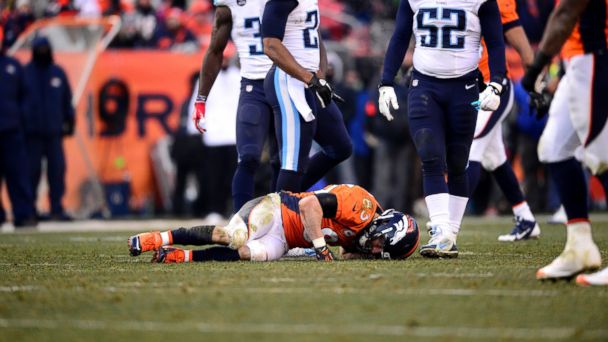Sports Leagues, Athletes Talk Concussions with DC Lawmakers
The NFL joined representatives from the NHL and medical doctors to let Congress know how head injuries are impacting American athletes from junior programs to the pros, saying they are devising safer helmets to guard against the chances of players suffering concussions.
Jeffery Miller, Senior Vice President for Player Health and Safety Policy at the National Football League, testified in Washington that while "football has earned a vital place in the rhythm of American life," helmets for players have not caught up to what is necessary to protect players.

Credit: AAron Ontiveroz/The Denver Post/Getty Images
"Football helmets were designed to protect against skull fractures and they do a fabulous job of that they were not designed to prevent against concussions and so that sort of technology or design I know the helmet manufactures are working on it, we are not there yet and the league is doing what it can to inspire that especially with our partnership with GE and Under Armour to get new ideas around that," Miller said.
"The other thing we do is we do regular helmet testing in concert with our friends at the players association so we can inform the players of which helmets are working best."
According to Miller, nearly 6 million kids play tackle or flag football in the U.S. Approximately 1.1 million that play in high school 75,000 in college.
And they take the hits, just like the pros.
"We take that popularity seriously, with it comes a great deal of responsibility and that's one we embrace," Miller said.
A few years ago, the NFL changed regulation for the kickoff-moving it five yards to help reduce concussions. According to Miller, that has been working.
"We had identified the kickoff and the kickoff return as the single most dangerous play in our sport as related to the number of concussions," he said. "So by moving it forward by 5 yards we decreased the number of concussions on that particular play by 40 percent."
He added the NFL has done other work to help reduce concussions in play, such as adding trauma consultants on the sideline that's a concussion expert and encouraging players to lower target tackling zones, while penalizing head-to-head hits.
At the NHL, they too emphasized work being done to reduce traumatic head collisions, head-to-head and fist-to-head.
This season, "68 percent of the games played have been completely free of fighting. The highest such percentage since 2006 and the number of major penalties assessed for fighting is down 15 percent from last season and down 31 percent since the 2010 season," said William Daly III, NHL Deputy Commissioner.
Doctors, however, testified that the sports are inherently violent.
"That's one of the reasons we love it, the forces encountered in football can be huge, consider a big hit between a running back and a linebacker at full speed," Dr. Timothy Gay, professor of Atomic, Molecular & Optical Physics, University of Nebraska-Lincoln testified. "We can show using newton's second law that the force each player exerts on the other exceeds three-quarters of a ton. This is who football is called a contact sport. Two players who collide at full speed helmet to helmet are experiencing the same force to their heads that one of them would feel if he had a 16 pound bowling ball dropped onto his head from a height of eight feet."
He added that the amount of energy at the line of scrimmage on any given play has almost doubled since 1920 due to increases in player's weight and size.
For soccer, players typically head the ball up to 12 times in a single game. And that black and white sphere can travel up to 50 miles per hour.
Briana Scurry, a goalkeeper for the U.S. Women's National Soccer Team during the 1999 World Cup, said concussions can be life altering.
"I'm not finding that soccer has completely grasped the alarm or the situation like USA Football USA Hockey have, part of the reason I'm here today is to shed light that soccer too should be instrumenting different protocols like the NHL and NFL are and hopefully the governing body for soccer which is US soccer will start to understand that our great sport is in danger of having too many head injuries and that something does need to be done about it and something needs to instrumented," she said.
Last month, Boston University announced that the first soccer player was diagnosed with Chronic Traumatic Encephalopathy (CTE). Patrick Grange who died at age 29 in 2012 has brought newfound attention to the sport formerly thought of as "safer" than football or hockey.
Ian Heaton, a senior at Bethesda-Chevy Chase High School in Bethesda, Maryland, has spent the past 2-and-a-half years recovering after a concussion left him with only 5 percent of normal cognitive activity and almost immobilized. For him losing would have been better than the lasting effects a concussion brings.
"Frankly I would actually encourage the coaches to stress this as much as possible as well as the parents because the coaches and the parents are there to help us learn how to play these sports correctly and if they can emphasize not having to worry about winning to the point where you get hurt then it will trickle down to the players and the players become coaches and then it's the never ending cycle of teaching and making sure that the players know that winning is not the most important thing," Heaton testified. "You know it feels great to win but I'd much rather lose than have another concussion."